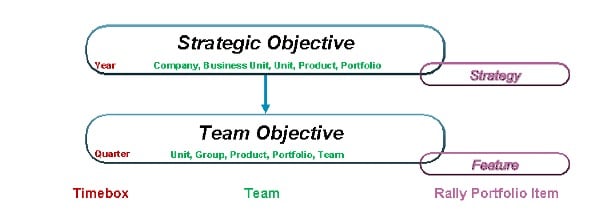May 31, 2023

Rally OKRs vs. SAFe PI Objectives: The Differences, and Why They Matter

Written by: Ian McGinnis
|
Key Takeaways
|
|
The term “objective” is quite overloaded these days. It is used to refer to many different concepts, and this can cause confusion. One question I hear a lot is, “Can’t we just use Rally’s Objectives (OKRs) for our PI Objectives?” Or, alternatively, “Aren’t PI Objectives the same as OKRs?”
In this article, we are going to show that while these terms share a critical keyword and a few other similar features, they are different, and not interchangeable.
Let’s start by looking at each one, then focus on the differences between the two.
SAFe PI Objectives
First, here’s a definition of SAFe PI Objectives from the SAFe website:
“Planning Increment (PI) Objectives are a summary of the business and technical goals that an Agile Team or train intends to achieve in the upcoming Planning Increment (PI). During PI Planning, teams create PI objectives, which are the things they intend to accomplish in the upcoming Program Increment (PI).”
© Scaled Agile, Inc.
From this definition, we can see a few things. First, PI Objectives summarize a team’s goals for a specific Planning Increment (PI). There is a common misconception that PI Objectives guide teams toward what they should do in a PI. In fact, they summarize what a team will do—what they have committed to do—in a PI. This distinction is important.
PI Objectives are created during PI Planning, after teams decide what they will commit to in the PI. Why would you create an objective after you have decided what you will do—is that even necessary? Clues abound in the discussion on PI Objectives on the SAFe website, where the word “communicate” shows up several times.
Teams in an Agile Release Train (ART) write PI Objectives to communicate their “intent” for a PI to the Business Owners. Those Business Owners then rate the business value of that intent. The Business Owners do this first, right after PI Planning, to create a Planned Business Value (BV). Basically, the Business Owners are saying that if the team achieves this PI Objective (let’s call it <PI Obj A>), they expect it will have this value for the business.
Business Owners perform this rating activity again after the System Demo, which produces an Actual Business Value for each PI Objective. Because this value is based on what the team built for <PI Obj A>, the Business Owners are saying that they believe it has this actual value for the business.
Finally, the ratio of the Actual BV to the Planned BV (Actual BV/Planned BV x 100) is used to calculate the ART Predictability Measure metric. This metric is tracked from PI to PI for each team and for the ART as a whole. The following diagram from the SAFe 6.0 website shows an example, with Planned (EV) and Actual (AV) values. We can see that the ART Predictability Measure is 90%.

SAFe PI Objectives really are a way to measure the effectiveness of communication and collaboration between Business Owners and the ART, via the ART Predictability Measure.
Rally objectives
Now, let’s cover Rally Objectives.
In Rally, Objectives implement the Objectives and Key Results (OKR) model originally popularized by John Doerr.
In this model, Objectives are straightforward, qualitative statements of a team’s goals. Each Objective has Key Results, which are quantitative measures that, if met, indicate that the goal has been achieved.
OKRs are a goal setting framework, and as such, they inform and drive the work that teams will do in an OKR Cycle, which is typically one quarter. They are created before a team begins that work and aligned with the overall Objectives of the larger organization. OKRs guide teams on what work they should do and help them prioritize one work item over another. While there may be “business as usual” tasks that a team must do, which won’t be covered by an OKR, the most important activities a team does should align with that team’s OKRs.
In Rally, the relationship between an Objective and Work is configurable. A simple use case in Rally might look something like this:

The verdict: Rally objectives are not PI objectives
Now that we’ve described each type of objective, it should be clear that while they are both called “objectives,” they are not the same. They were developed with very different purposes in mind. Rally Objectives (OKRs) implement a goal setting framework that drives the work teams do. On the other hand, SAFe PI Objectives support a metric that measures effectiveness of communication and collaboration between Business Owners and ARTs.
What does Scaled Agile, Inc. (SAI), the creator of SAFe, say about using OKRs as PI Objectives? They recommend against it. They have published a very good article on using OKRs in SAFe. In that article, they identified three strong use cases for OKRs in the SAFe framework:
- Enhancing strategic alignment across a SAFe portfolio
- Defining business outcomes for epics and lean business cases
- Setting improvement goals for the SAFe transformation
We agree with this article and note that Rally Objectives can be easily and effectively used for all three use cases that the SAI describes.
Conclusion
We have two items, with very similar names—in fact, they are both called objectives.
But, after the discussion above, it should be clear that Rally Objectives and SAFe PI Objectives aren’t the same. Agile teams use them in very different ways and for different purposes.
Keep the differences in mind and choose the one that is right for the job. If you do, you will find that your objectives—whatever those are—will be easier to see and achieve.

Ian McGinnis
Ian McGinnis is an architect of agile solutions with over 30 years of experience in software development. At Rally, he serves as an Executive Advisor, working directly with Fortune 100 companies to help them adopt true business agility. Ian is passionate about helping organizations figure out how to make business...
Other resources you might be interested in
DX NetOps Smarts: Overview
Learn how DX NetOps Smarts discovers hybrid environments to map complex topologies, then provides unified real-time monitoring with advanced fault management and automated root-cause analysis.
Top 3 Trends Defining Network Observability in 2026
Discover the three specific trends that will define network observability in 2026. See how unified observability and predictive AI will shape the landscape.
Rally Office Hours: December 18, 2025
Rally Office Hours features an AI-driven artifact breakdown tool that creates child items from features/stories. The Q&A covers capacity planning, forecasting and burnup charts.
Why 2025 Shattered the Old Rules of Network Management
This post reveals the five key lessons network operations leaders learned in 2025—and how they need to respond to be successful in 2026.
The 2026 VMUG Report: Why Network Observability is the Heart of the New VCF Era
Get the top takeaways from the VMUG Cloud Operations and VCF User Experience Report 2026. See why network observability is key to successful VCF 9 migrations.
Automic Automation Cloud Integration: SAP S/4 HANA Application Jobs Integration
Simplify your SAP S/4HANA job management. Integrate with Automic Automation for central configuration, monitoring, and orchestration of all your enterprise jobs.
Automic Automation Cloud Integration: OpenSSH Integration
Master Open SSH automation. Use Automic Automation for centralized control, secure file transfer, command execution, and full job monitoring.
Rally Office Hours: December 11, 2025
Discover Rally's new Ancestors field, static query box deprecation, non-conflicting saves, plus a dashboard demo and query writing tips.
3 Questions I Expect You to Ask Me
Ask these questions to gain a deeper understanding of a vendor. Find a partner who can solve today’s challenges and prepare you for what’s next.